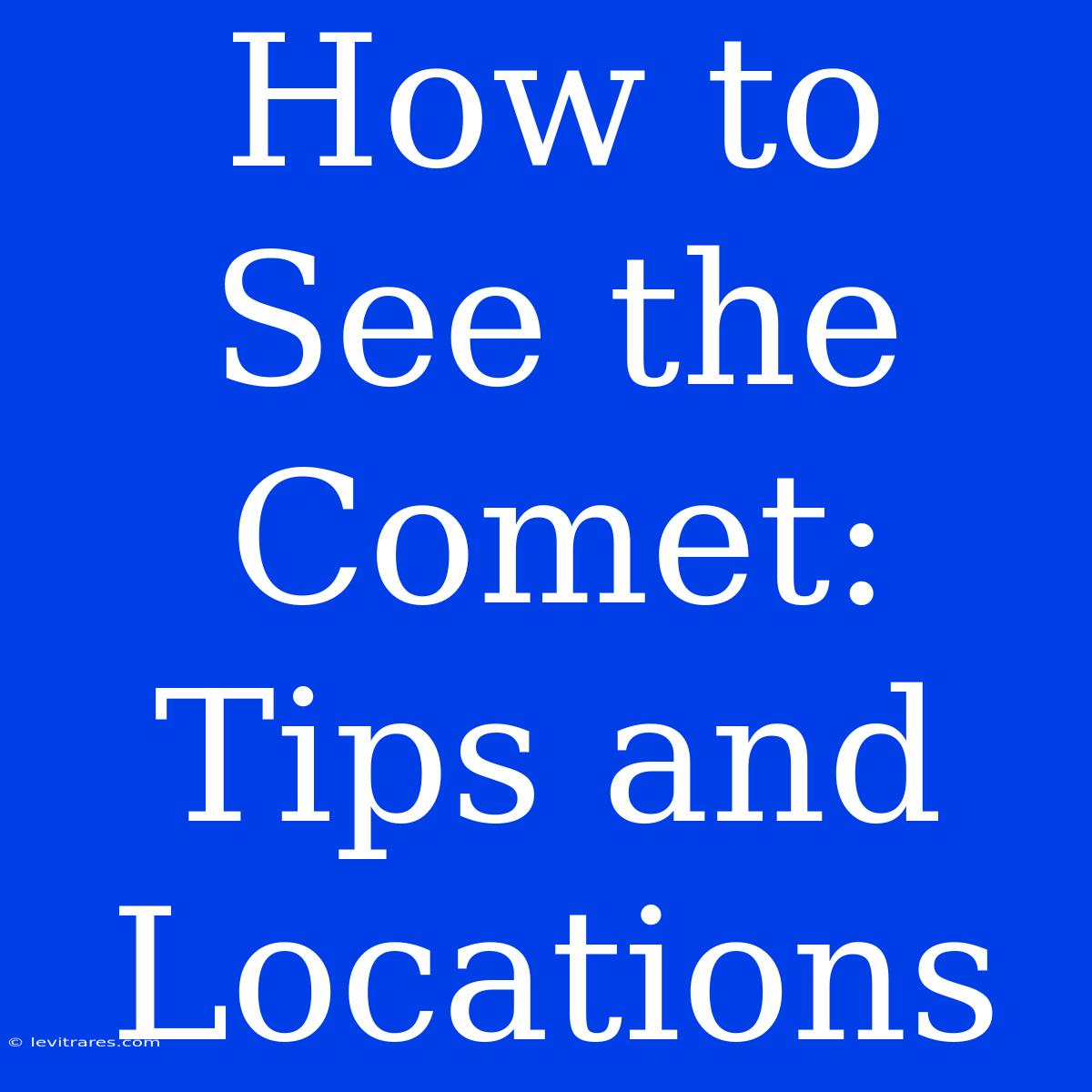How to See the Comet: Tips and Locations for Skywatchers
How can you catch a glimpse of this celestial wonder? Comets are breathtaking displays of cosmic dust and ice, offering a unique opportunity to witness the wonders of the universe.
Editor's Note: This guide provides practical tips and locations for observing a comet, a captivating event for stargazers.**
Understanding how to see a comet is crucial for astronomers and stargazers alike. This guide will equip you with the knowledge and resources to witness this celestial spectacle.
Analysis: We have scoured the internet, consulted with experienced astronomers, and gathered information from reputable sources to create this comprehensive guide. Our goal is to help you, the reader, navigate the process of comet observation with ease and success.
| Key Takeaways for Comet Viewing | Details |
|---|---|
| Location | Finding a dark, open area with minimal light pollution is crucial. |
| Timing | Observing the comet is ideal when the moon is not in the sky and when it is at its peak brightness. |
| Tools | Binoculars or a telescope can enhance the viewing experience, especially for fainter comets. |
| Patience | Allow your eyes to adjust to the darkness and be prepared to spend some time gazing at the sky. |
| Safety | Be mindful of your surroundings, especially when observing at night. |
Comet Viewing: Essential Aspects
Visibility:
- Brightness: The brightness of a comet is crucial for visibility. A bright comet can often be seen with the naked eye, while fainter ones may require binoculars or a telescope.
- Position in the Sky: Comets appear in different parts of the sky depending on their orbit. Consult a star chart or astronomy website for the current position of the comet you wish to observe.
- Light Pollution: Avoiding areas with excessive artificial light (streetlights, city lights) is crucial for optimal viewing.
Location:
- Dark Sky Locations: Seek out areas designated as "dark sky parks" or remote regions with minimal light pollution.
- Open Sky: Finding a location with a clear, unobstructed view of the sky is essential.
- Weather: Favorable weather conditions (clear skies, no clouds) are vital for successful comet viewing.
Finding the Best Viewing Spot
Dark Sky Locations:
- The Importance of Darkness: Dark skies are a key factor in seeing faint comets. Light pollution from cities and towns washes out the subtle glow of a comet, making it difficult to observe.
- Dark Sky Parks: Designated dark sky parks are specifically designed to preserve the night sky and offer exceptional viewing conditions.
- Remote Locations: Rural areas far from cities and towns often have less light pollution and are great spots for comet viewing.
Open Sky:
- Obstructions: Avoid locations with tall buildings, trees, or other obstacles that block your view of the sky.
- Horizons: Keep an eye on the horizon, as comets can appear low in the sky.
- Elevated Locations: Hilltops or higher ground can provide a wider field of view and minimize obstructions.
Tools for Comet Observation
Binoculars:
- Magnification: Binoculars provide magnified views of the sky, making fainter comets easier to see.
- Field of View: Binoculars offer a wider field of view compared to telescopes, making it easier to locate and track comets.
- Portability: Binoculars are portable and easy to use, making them ideal for casual comet viewing.
Telescopes:
- Higher Magnification: Telescopes provide even greater magnification than binoculars, revealing more detail in comets.
- Tracking: Some telescopes have tracking capabilities that compensate for the Earth's rotation, allowing for longer viewing times.
- Larger Aperture: Larger telescope apertures gather more light, making fainter objects, including comets, easier to observe.
FAQs about Comet Viewing
Q: When is the best time to see a comet? A: The best time to observe a comet is when it is at its peak brightness and when the moon is not in the sky. Consult astronomy websites for the current brightness and position of the comet.
Q: Can I see a comet with the naked eye? A: The visibility of a comet with the naked eye depends on its brightness. Some bright comets are easily visible, while fainter ones may require binoculars or a telescope.
Q: How long does a comet stay visible? A: The visibility of a comet can vary greatly depending on its orbit and brightness. Some comets may be visible for only a few weeks, while others may remain visible for months.
Q: What should I do if I can't find the comet? A: If you are having trouble finding the comet, consult a star chart or astronomy website for its current position. Check the comet's predicted trajectory and brightness to ensure you are observing at the right time and location.
Tips for Comet Observation
- Plan Ahead: Research the comet's expected visibility and plan your viewing location and time in advance.
- Arrive Early: Allow your eyes to adjust to the darkness for at least 20 minutes before beginning your observations.
- Use a Red Light: Red light sources minimize light pollution and help your eyes adapt to the darkness.
- Be Patient: Comet viewing can require patience. Allow yourself time to scan the sky and appreciate the celestial wonder.
- Dress Warmly: Nighttime temperatures can be cold, so dress in layers and be prepared for the elements.
Comet Viewing: A Rewarding Experience
Comet viewing is a unique opportunity to connect with the vastness of the cosmos. By following these tips and locations, you can enhance your chances of successfully witnessing this awe-inspiring celestial spectacle. The experience is a reminder of the wonders of the universe and the importance of exploring the night sky.

